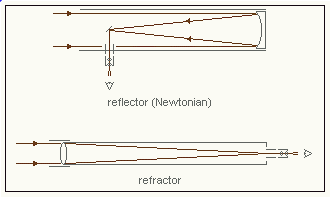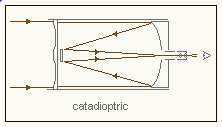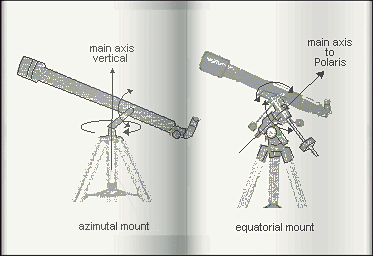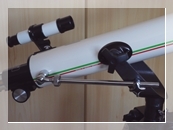
Telescopes are amateur astronomers tools. They come in a great variety of types. Mounts are these devices which allow a telescope's pointing and celestial objects tracking
Telescopes
Amateur astronomers telescopes are optical instruments working on a same basis. A primary light-gathering device collects light and brings it to a focus point where it is magnified for display by an eyepiece (an eyepiece is a small lens ensemble). Telescopes sort first according to what primary light-gathering device they are using: will it be a lens atop the instrument, the telescope will be called a "refractor" (as the lens is refracting the light); will the telescope use a mirror as primary optics, it will be called a "reflector" (as the mirror is reflecting the light). Due to light path, celestial objects images are most of the time reverted in some way (upside-down, left-right, etc). This is a normal characteristic of astronomical instrument. To use astronomy instrument for terrestrial purposes, you will have to use accessories correcting light path (newtonians telescopes may not be corrected this way)


All amateur telescopes are sorting based on this difference. Main amateur telescopes types are further differentiated into other categories however. These categories are more related to types which are actually found on the market. A telescope, generally, with a aperture twice the one of a other, for example, displays twice more details than the latter
- refractors have a lens atop a tube. At the other extremity of the tube is found the focuser and the eyepiece. Refractors are renowned to be expensive. On another hand they are certainly the best instruments available as providing a sharp, high contrast and as they allow high magnifications. Compared to most of optical systems with a secondary miror, refractors are providing for very luminous images because no secondary is coming to decrease the quantity of light reaching the primiray. They are not good at deep-sky objects however and are best at planetary objects, Moon, and binary stars. Most simple and inexpensive models are good initiation tools. As refractors work based upon a lens, they are subject to a defect named 'chromatic aberration.' Chromatic aberration results from that each wavelength of light, or color of the prism, is focused by a lens at a different focus point, like red focused farther than blue. That defect is much more a annoyance in terms of astrophotography with cameras more sensitive to it. Refractors come into the achromatic or apochromatic varieties. Cheeper achromatic refractors work with two lenses, or a doublet with chromatic aberration minimized as more expensive apochromatic ones with three lenses, or triplet, which bring all the light spectrum to a same focus, are eliminating the defect. A large F/D value with a achromatic allows to decrease the chromatic aberration. Apochromatics with a small F/D are better used for stellar fields. A intermediary type of refractors, or very good achromats, fight chromatic aberration -without totally eliminating it- using two lenses made of special glas, like extra-low dispersion ('ED') or fluorite. Such special glass may also be used to improve 3-lens apochromatics still
- Schmidt-Cassegrains ("Schmidt-Cassegrain Telescopes", SCTs) are catadioptric telescopes, that is a mix of refractors and reflectors -- hence there are also called compound telescopes -- : light is entering the tube through a correcting lens. It is reflected at the bottom of the instrument by a primary mirror unto a secondary which brings the light to the focuser and eyepiece through a hole in the primary. Schmidt-Cassegrains are expensive (althoug less than refractors) but are all-around, multi-purpose instruments. They are excellent for deep-sky visual observation because of very sharp images on a wide-field, and they are very good for Moon, planets, and binaries. They are the instruments better suited for deep-sky astrophotography. Schmidt-Cassegrains are not optical error-free, of which coma, which is a elongation of pictures in a comet-shape when one nears the field's edge. Some advanced models are corrected. In terms of collimation, collimation of a Schmidt-Cassegrain concerns the secondary mirror only
- Ritchey-Chrétiens are kinds of Schmidt-Cassegrain corrected from optical aberrations as they are tools specially dedicatad to stellar photography
- Maksutov-Cassegrains are catadioptrics too but with a thicker correcting lens and a smaller secondary mirror than SCTs, they have a slight advantage about planets due to a lesser secondary mirror obstruction. Maksutov-Cassegrains, due a important F/D are better used with celestial objects necessitating a important magnification, planets that is
- newtonians are the most basic reflectors (light enters an open tube, is reflected by a primary mirror to a secondary which sends light on the side atop the instrument) and were amateurs favourites during a long time due to their relatively low cost and their versatility. Newtonians are good a deep sky objects, good for deep-sky astrophotography, and reasonably good for planets and Moon. They are optically less good than SCTs however. Main unconvenience of newtonians is that they have to be collimated (regular alignment of the primary and the secondary mirror) and that due to their open tube they are subject to turbulence. Their coatings may degrade. Despite that they are needing to be collimated -to often align their primary-secondary-ocular holder- Newtons are polyvalents tools allowing to planetary and stellar and visual-astrophotography. A Newton with a F/D value at 8 is more versatile that a refractor with the F/D › 10
- dobsonians are large newtonians. Small ones are initiation tools. These instruments are great light collectors and good at dark sky from non-light polluted locations. Their relatively low pricing is mainly due to their simple wooden mount. They cannot be motor driven, as their motion is hand-controled only
More categories may be found like Newtonian-Cassegrains (a correcting lens but a light egress like a newtonian) or more exotic species. A recent trend are short-focal/wide-field refractors (either achromat or higher-end apochromat) which are presented like good at deep-sky objects and planets at the same time (planets with a Barlow or short-focal eyepieces, as the Barlows are said to have nothing more in common with the former bad reputation of such accessories among the amateurs). The advantage of such instruments is their portability and their ease of set up. This is a new attitude compared to instruments of one or two decades ago when comet hunters were looking for such tools, or their binocular equivalent, planetary observers were preferring long-focal refractors and SCTs where the multi-purpose, high-end instruments
Telescopes, whatever their type, are affixed onto a mount. Mount proper is the device which allows telescope motion and pointing. It is found atop of the tripod, or of the pedestal or pier. Mounts come in two flavours due to how they handle the dual-axis motion necessary to follow a celestial object moving along the sky apparent motion

- azimutal mounts are present with beginners' instruments. Such mounts need a dual axis motion to follow a celestial object. Due to night sky apparent motion and Earth's axis tilt, any sky object in a mid-northern or mid-southern sky is rising -or descending- at the same time it is moving East-West. As the name, the azimutal mount necessitates an azimutal, East-West motion, and an altitude motion (high-low). Good beginners instruments' azimutal mounts are featuring a system with a micrometrical screw which allows a fine setting of the telescope's altitude once the latter set. Once the object observed centered, the telescope's motion in azimuth and altitude to keep it such is then pleasant
- dobsonian azimutal. Dobsons are fitted with a specific mount which are a azimuthal one. Such mounts now come in improved versions. The 'Push To' version has the user moving the telescope according to indicating arrows or the 'Goto' features one engine for each axis and a automated search)
 | A micrometrical screw allows to a fine tuning of a azimutal mount's altitude! site 'Amateur Astronomy' |
- altazimutal (or altaz) mounts are basically azimutal mounts augmented with a dual-axis electric motion and tracking systems. They are featured by advanced telescopes like SCTs at Meade or Celestron as such mounts are also suitable for astrophotography
- equatorial (or polar, or German) mounts came before those high-end altazimuthals, and are still useful (and necessary for astrophotography). They allow too a simplier tracking as their main axis is tilted to the Polaris, thus parallel to Earth axis, instead of being vertical as the case in an altazimutal. Once an object acquired in altitude, the rotation of the main axis at the opposite of Earth's rotation is enough to follow its apparent motion. Due to the awkward configuration such equatorial mounts may attain, they feature counterweights at one end of the secondary axis. Such equatorial mounts usually may be fitted with motors on both axis. Main axis is moving at Earth's rotation rate; secondary axis is used for corrections. High-end altazimutals may be transformed into equatorials using a proprietary wedge which tilts the mount main axis. In terms of astrophotography, equatorial mounts have that advantage that you will not need to use a accessory termed a 'fied de-rotator,' which has to be used with altazimuthal mounts to maintain a similarly framed field along the exposure time
Website Manager: G. Guichard, site 'Amateur Astronomy,' http://stars5.6te.net. Page Editor: G. Guichard. last edited: 4/11/2016. contact us at ggwebsites@outlook.com




